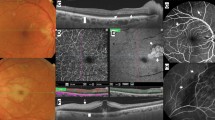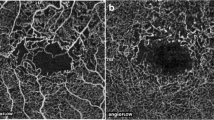Summary
Three hundred unselected, lateral arteriograms of internal carotid arteries and 100 unselected, lateral arteriograms of common carotid arteries were examined for presence of ocular choroid blush. It was identified in 100% of the arteriograms of normal common carotid arteries and 98% of those demonstrating normal internal carotid arteries. Absence of choroid blush on internal carotid arteriograms may be due to anomalous ophthalmic artery origin from an external carotid artery branch. Otherwise, absence of choroid blush indicates intracranial or orbital disease. In 7 of 11 additional patients with severe stenosis or occlusion of the internal carotid artery, choroid blush was absent.
Résumé
Les auteurs ont étudié 300 artériographies carotidiennes internes de profil non selectionnées et 100 artériographies carotidiennes primitives de profil non sélectionnées à la recherche d'un blush choroïdien oculaire. Il put être mis en évidence dans 100% des artériogrammes carotidiens primitifs normaux et dans 98% des artériogrammes carotidiens internes normaux. L'absence du blush choroïdien sur les artériogrammes carotidiens internes peut être due à une anomalie de l'origine de l'artère ophtalmique lorsque celle-ci provient d'une branche de l'artère carotide externe. Dans d'autres cas, l'absence de blush choroïdien indique une affection intracranienne ou orbitaire. Chez 7 sur 11 autres malades presentant d'importantes sténoses ou occlusion de l'artére carotide interne, le blush choroïdien était absent.
Zusammenfassung
Es erfolgte eine Auswertung von 300 lateralen Arteriogrammen der A. carotis interna und 100 lateralen Arteriogrammen der A. carotis communis. Bei den Arteriographien der A. carotis communis konnte in allen Fällen die Anfärbung des Plexus nachgewiesen werden, bei den normalen Interna-Arteriographien war diese Anfärbung in 98% der Fälle erkennbar. Läßt sich die Anfärbung nicht nachweisen, kann eine Anomalie am Ursprung der A. opthalmica vorliegen, es besteht auch die Möglichkeit von intracraniellen und Orbita-Erkrankungen.
Similar content being viewed by others
References
Brucher, J.: Origin of the ophthalmic artery from the middle meningeal artery. Radiology 93, 51–52 (1969).
Di Chiro, G.: Ophthalmic arteriography. Radiology 77, 948–957 (1961).
Di Chiro, G.: Angiographic topography of the choroid. Amer. J. Ophthal. 54, 232–237 (1962).
Dilenge, D., Fischgold, H., David, M.: L'Angiographie par soustraction de l'artère ophtalmique et de ses branches. Paris: Masson et Cie 1965.
Hayreh, S.S., Dass, R.: The ophthalmic artery. I. Origin and intra-cranial and intra-canalicular course. Brit. J. Ophthal. 46, 65–98 (1962).
Huckman, M.S., Haas, J.: The etiology of neovascular glaucoma secondary to internal carotid artery occlusion. Presented at the Tenth Annual Meeting of the American Society of Neuroradiology, Mexico City, Feb. 21–24 (1972).
Kolker, A.E., Hetherington, J., Jr.: Becker-Shaffer's diagnosis and therapy of the glaucomas, 3rd ed., p. 242. St. Louis: C. V. Mosby 1970.
Krayenbühl, H.: Diagnostic value of orbital angiography. Brit. J. Ophthal. 42, 180–190 (1958).
Schurr, P.H.: Angiography of the normal ophthalmic artery and choroidal plexus of the eye. Brit. J. Ophthal. 35, 473–478 (1951).
Stabler, J.: Two cases of accessory middle cerebral artery, including one with an aneuryms at its origin. Brit. J. Radiol. 43, 314–318 (1970).
Taveras, J.M., Wood, E.H.: Diagnostic Neuroradiology, p. 1497. Baltimore: Williams and Wilkins Co. 1964.
Wheeler, E.C., Baker, H.L., Jr.: The ophthalmic arterial complex in angiographic diagnosis. Radiology 83, 26–35 (1964).
Author information
Authors and Affiliations
Rights and permissions
About this article
Cite this article
Handel, S.F., Stargardter, F.L., Glickman, M.G. et al. Frequency of the ocular choroid blush during arteriography. Neuroradiology 6, 50–55 (1973). https://doi.org/10.1007/BF00338859
Issue Date:
DOI: https://doi.org/10.1007/BF00338859




